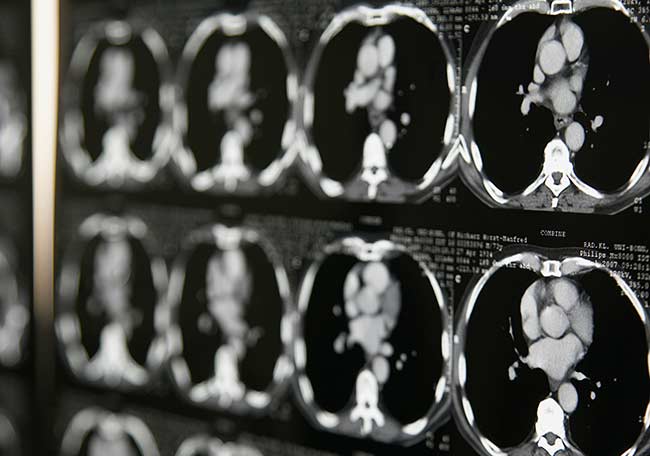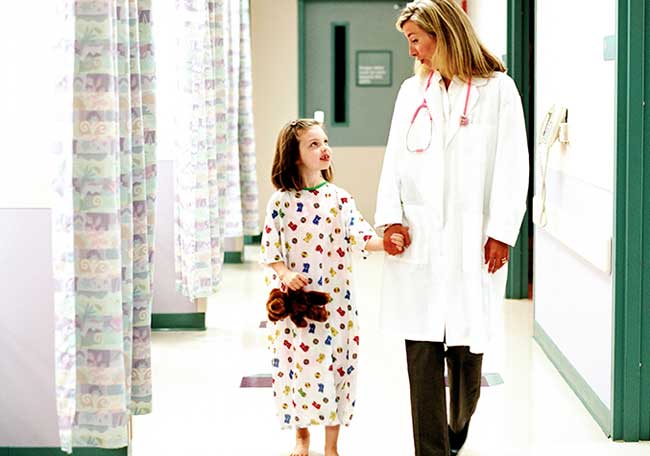Leucemia mieloide aguda en niños

Referencias
1 Horibe K, Saito AM, Takimoto T et al. Incidence and survival rates of hematological malignancies in Japanese children and adolescents (2006–2010): Based on registry data from the Japanese Society of Pediatric Hematology. Int. J. Hematol. 2013; 98: 74–88.
2 Tomizawa D, Tabuchi K, Kinoshita A et al. Repetitive cycles of high-dose cytarabine are effective for childhood acute myeloid leukemia: Long-term outcome of the children with AML treated on two consecutive trials of Tokyo Children’s Cancer Study Group. Pediatr. Blood Cancer 2007; 49: 127–32.
3 Tsukimoto I, Tawa A, Horibe K et al. Risk-stratified therapy and the intensive use of cytarabine improves the outcome in childhood acute myeloid leukemia. J. Clin. Oncol. 2009; 27: 4007–13.
4 Taga T, Shimomura Y, Hori T et al. A morphology-based approach for the treatment of children with acute myeloid leukaemia: A report from the Japanese Children’s Cancer and Leukemia Study Group AML 9805 Study. Jpn J. Pediatr. Hematol. 2010; 24: 283–91.
5 Tomizawa D, Tawa A, Watanabe T et al. Excess treatment reduction including anthracyclines results in higher incidence of relapse in core binding factor acute myeloid leukemia in children. Leukemia 2013; 27: 2413–6.
6 Tomizawa D, Tawa A, Watanabe T et al. Appropriate dose reduction in induction therapy is essential for the treatment of infants with acute myeloid leukemia: A report from the Japanese Pediatric Leukemia/Lymphoma Study Group. Int. J. Haematol. 2013; 98: 578–88.
7 Kinoshita A, Miyachi H, Matsushita H et al. Acute myeloid leukemia with myelodysplastic features in children. A report of Japanese Pediatric Leukemia/Lymphoma Study Group. Br. J. Haematol. 2014; 167: 80–6.
8 Rubnitz JE, Inaba H, Dahl G et al. Minimal residual disease directed therapy for childhood acute myeloid leukaemia: Results of the AML02 multicentre trial. Lancet Oncol. 2010; 11: 543–52.
9 Abrahamsson J, Forestier E, Heldrup J et al. Response-guided induction therapy in pediatric acute myeloid leukemia with excellent remission rate. J. Clin. Oncol. 2011; 29: 310–5.
10 Gibson BE, Webb DK, Howman AJ et al. Results of a randomized trial in children with acute myeloid leukaemia: Medical Research Council AML12 trial. Br. J. Haematol. 2011; 155: 366–76.
11 Creutzig U, Zimmermann M, Bourquin J et al. Randomized trial comparing liposomal daunorubicin with idarubicin as induction for pediatric acute myeloid leukemia: Results from Study AML-BFM 2004. Blood 2013; 122: 37–43.
12 Pession A, Masetti R, Rizzari C et al. Results of the AIEOP AML 2002/01 multicenter prospective trials for the treatment of children with acute myeloid leukemia. Blood 2013; 122: 170–8.
13 Gamis AS, Alonzo TA, Meshinchi S et al. Gemtuzumab ozogamicin in children and adolescents with de novo acute myeloid leukemia improves event-free survival by reducing relapse risk: Results from the randomized phase III Children’s Oncology Group trial AAML0531. J. Clin. Oncol. 2014; 32: 3021–32.
14 Rai KR, Holland JF, Glidewell OJ et al. Treatment of acute myelocytic leukemia: A study by cancer and leukemia group B. Blood 1981; 58: 1203–12.
15 Hann IM, Stevens RF, Goldstone AH et al. Randomized comparison of DAT versus ADE as induction chemotherapy in children and younger adults with acute myeloid leukemia. Results of the Medical Research Council’s 10th AML trial (MRC AML10). Adult and Childhood Leukaemia Working Parties of the Medical Research Council. Blood 1997; 89: 2311–8.
16 Ho PA, Alonzo TA, Gerbing RB et al. Prevalence and prognostic
implications of CEBPA mutations in pediatric acute myeloid leukemia (AML): A report from the Children’s Oncology Group. Blood 2009; 113: 6558–66.
17 Hollink IH, Zwaan CM, Zimmermann Metal. Favorable prognostic impact of NPM1 gene mutations in childhood acute myeloid leukemia, with emphasis on cytogenetically normal AML. Leukemia 2009; 23: 262–70.
18 Shimada A, Take T, Mabuchi K et al. KIT mutations, and not FLT3 internal tandem duplication, are strongly associated with a poor prognosis in pediatric acute myeloid leukemia with t (8; 21): A study of the Japanese Childhood AML Cooperative Study Group. Blood 2006; 107: 1806–9.
19 Pollard JA, Alonzo TA, Garbing RB et al. Prevalence and prognostic significance of KIT mutations in pediatric patients with core binding factor AML enrolled on serial pediatric cooperative trials for de novo AML. Blood 2010; 115: 2372–9.
20 Mayer RJ, Davis RB, Schaffer CA et al. Intensive post remission chemotherapy in adults with acute myeloid leukemia. Cancer and Leukemia Group B. N. Engl. J. Med. 1994; 331: 896–903.
21 Byrd JC, Ruppert AS, Mrózek K et al. Repetitive cycles of high dose cytarabine benefit patients with acute myeloid leukemia and inv (16) (p13q22) or t (16; 16) (p13; q22): Results from CALGB 8461. J. Clan. Once. 2004; 22: 1087–94.
22 Creutzig U, Zimmermann M, Bourquin JP et al. Second induction with high-dose cytarabine and mitoxantrone: Different impact on pediatric AML patients with t (8; 21) and with inv (16). Blood 2011; 118: 5409–15.
23 Smith FO, Alonzo TA, Gerbing RB, Woods WG, Arceci RJ. Long term results of children with acute myeloid leukemia: A report of three consecutive Phase III trials by the Children’s Cancer Group: CCG 251, CCG 213 and CCG 2891. Leukemia 2005; 19: 2054–62.
24 Woods WG, Neudorf S, Gold S et al. A comparison of allogeneic bone marrow transplantation, autologous bone marrow transplantation, and aggressive chemotherapy in children with acute myeloid leukemia in remission. Blood 2001; 97: 56–62.
25 Lange BJ, Smith FO, Feusner J et al. Outcomes in CCG-2961, a children’s oncology group phase 3 trial for untreated pediatric acute myeloid leukemia: A report from the children’s oncology group. Blood 2008; 111: 1044–53.
26 Entz-Werle N, Suciu S, van derWerff ten Bosch J et al. Results of 58 872 and 58 921 trials in acute myeloblastic leukemia and relative value of chemotherapy vs. allogeneic bone marrow transplantation in first complete remission: The EORTC Children Leukemia Group report. Leukemia 2005; 19: 2072–81.
27 Stevens RF, Hann IM, Wheatley K, Gray RG. Marked improvements in outcome with chemotherapy alone in paediatric acute myeloid leukemia: Results of the United Kingdom Medical Research Council’s 10th AML trial. MRC Childhood Leukaemia Working Party. Br. J. Haematol. 1998; 101: 130–40.
28 Webb DKH, Wheatley K, Harrison G et al. Outcome for children with relapsed acute myeloid leukemia following initial therapy in the Medical Research Council (MRC) AML 10 trial. Leukemia 1999; 13: 25–31.
29 Aladjidi N, Auvrigno A, Leblanc T et al. Outcome in children with relapsed acute myeloid leukemia after initial treatment with the French Leucemie Aique Myeloide Enfant (LAME) 89/91 protocol of the French Society of Pediatric Hematology and Immunology. J. Clin. Oncol. 2003; 21: 4377–85.
30 Wells RJ, Adams MT, Alonzo TA et al. Mitoxantrone and cytarabine induction, high-dose cytarabine, and etoposide intensification for pediatric patients with relapsed or refractory acute myeloid leukemia: Children’s Cancer Group Study 2951. J. Clin. Oncol. 2003; 21: 2940–7.
31 Abrahamsson J, Clausen N, Gustafsson G et al. Improved outcome after relapse in children with acute myeloid leukemia. Br. J. Haematol. 2007; 136: 229–36.
32 Sander A, Zimmermann M, Dworzak M et al. Consequent and intensified relapse therapy improved survival in pediatric AML: Results of relapse treatment in 379 patients of three consecutive AML-BFM trails. Leukemia 2010; 24: 1422–8.
33 Gorman MF, Ji L, Ko RH et al. Outcome for children treated for relapsed or refractory acute myelogenous leukemia (rAML): A therapeutic advances in childhood leukemia (TACL) consortium study. Pediatr. Blood Cancer 2010; 55: 421–9.
34 Kaspers GJL, Zimmermann M, Reinhardt D et al. Improved outcome in pediatric acute myeloid leukemia: Results of randomized trial on liposomal daunorubicin by the International BFM Study Group. J. Clin. Oncol. 2013; 31: 599–607.
35 Nakayama H, Tabuchi K, Tawa A et al. Outcome of children with relapsed acute myeloid leukemia following initial therapy under the AML99 protocol. Int. J. Hematol. 2014; 100: 171–9.
36 Inaba H, Coustan-Smith E, Cao X et al. Comparative analysis of different approaches to measure treatment response in acute myeloid leukemia. J. Clin. Oncol. 2012; 30: 3625–32.
37 van der Velden VH, van der Sluijs-Geling A, Gibson BE et al. Clinical significance of flow cytometric minimal residual disease detection in pediatric acute myeloid leukemia patients treated according to the DCOG ANLL97/MRC AML12 protocol. Leukemia 2010; 24: 1599–606.
38 Loken MR, Alonzo TA, Pardo L et al. Residual disease detected by multidimensional flow cytometry signifies high relapse risk in patients with de novo acute myeloid leukemia: A report from Children’s Oncology Group. Blood 2012; 120: 1581–8.
39 Fernandez HF, Sun Z, Yao X et al. Anthracycline dose intensification in acute myeloid leukemia. N. Engl. J. Med. 2009; 361: 1249–59.
40 Ohtake S, Miyawaki S, Fujita H et al. Randomized study of induction therapy comparing standard-dose idarubicin with high-dose daunorubicin in adult patients with previously untreated acute myeloid leukemia: The JALSG AML201 Study. Blood 2010; 117: 2358–65.
41 Bishop JF, Matthews JP, Young GA et al. A randomized study of high-dose cytarabine in induction in acute myeloid leukemia. Blood 1996; 87: 1710–7.
42 Weick JK, Kopecky KJ, Appelbaum FR et al. A randomized investigation of high-dose versus standard-dose cytosine arabinoside with daunorubicin in patients with previously untreated acute myeloid leukemia: A Southwest Oncology Group study. Blood 1996; 88: 2841–51.
43 Kern W, Estey EH. High-dose cytosine arabinoside in the treatment of acute myeloid leukemia: Review of three randomized trials. Cancer 2006; 107: 116–24.
44 Lowenberg B, Pabst T, Vellenga E et al. Cytarabine dose for acute myeloid leukemia. N. Engl. J. Med. 2011; 364: 1027–36.
45 Becton D, Dahl G, Ravindranath Y et al. Randomized use of cyclosporin A (CsA) to modulate P-glycoprotein in children with AML in remission: Pediatric Oncology Group Study 9421. Blood 2006; 107: 1315–24.
46 Ravandi F, Cortes J, Faderl S et al. Characteristics and outcome of patients with acute myeloid leukemia refractory to 1 cycle of high-dose cytarabine-based induction chemotherapy. Blood 2010; 116: 5818–23.
47 Jeha S, Razzouk B, Rytting Met al. Phase II study of clofarabine in pediatric patients with refractory or relapsed acute myeloid leukemia. J. Clin. Oncol. 2009; 27: 4392–7.
48 Inaba H, Rubnitz JE, Coustan-Smith E et al. Phase I pharmacokinetic and pharmacodynamic study of the multikinase inhibitor sorafenib in combination with clofarabine and cytarabine in pediatric relapsed/refractory leukemia. J. Clin. Oncol. 2011; 29: 3293–300.
49 Aplenc R, Blaney SM, Strauss LC et al. Pediatric phase I trial and pharmacokinetic study of dasatinib: A report from the children’s oncology group phase I consortium. J. Clin. Oncol. 2011; 29: 839–44.
50 Brandwein JM. Targeting polo-like kinase 1 in acute myeloid leukemia. Ther. Adv. Hematol. 2015; 6: 80–7.
51 Corrales-Medina FF, Manton CA, Orlowski RZ, Chandra J. Efficacy of panobinostat and marizomib in acute myeloid leukemia and bortezomib-resistant models. Leukemia Res. 2015; 39: 371–9.
52 ImAP, Sehgal AR, Carroll MP et al.DNMT3Aand IDH mutations in acute myeloid leukemia and other myeloid malignancies: Associations with prognosis and potential treatment strategies.
Leukemia 2014; 28: 1774–83.
53 Laszlo GS, Gudgeon CJ, Harrington KH et al. Cellular determinants for preclinical activity of a novel CD33/CD3 bispecific T-cell engager (BiTE) antibody, AMG 330, against human AML.
Blood 2014; 123: 554–61.
54 Pizzitola I, Anjos-Afonso F, Rouault-Pierre K et al. Chimeric antigen receptors against CD33/CD123 antigens efficiently target primary acute myeloid leukemia cells in vivo. Leukemia 2014; 28: 1596–605.
55 Bennet JM, Catovsky D, Daniel M-T et al. Proposal for the classification of the acute leukemias. Br. J. Haematol. 1976; 33: 451–8.
56 Vardiman JW, Thiele J, Arber DA et al. The 2008 revision of the World Health Organization (WHO) classification of myeloid neoplasms and acute leukemia: Rationale and important changes. Blood 2009; 114: 937–51.
57 Ohno R, Asou N, Ohnishi K. Treatment of acute promyelocytic leukemia: Strategy toward further increase of cure rate. Leukemia 2003; 17: 1454–63.
58 Wang ZY, Chen Z. Acute promyelocytic leukemia: From highly fatal to highly curable. Blood 2008; 111: 2505–15.
59 Tallman MS, Nabhan C, Feusner JH et al. Acute promyelocytic leukemia: Evolving therapeutic strategies. Blood 2002; 99: 759–67.
60 Sanz MA, Tallman MS, Lo-Coco F. Practice points, consensus, and controversial issues in the management of patients with newly diagnosed acute promyelocytic leukemia. Oncologist 2005; 10: 806–14.
61 Imaizumi M, Tawa A, Hanada R et al. Prospective study of a therapeutic regimen with all-trans retinoic acid and anthracyclines in combination of cytarabine in children with acute promyelocytic leukaemia: The Japanese childhood acute myeloid leukaemia cooperative study. Br. J. Haematol. 2011; 152: 89–98.
62 Sanz MA, Montesinos P, Rayon C et al. Risk-adapted treatment of acute promyelocytic leukemia based on all-transretinoic acid and anthracycline with addition of cytarabine in consolidation therapy for high-risk patients: Further improvements in treatment outcome. Blood 2010; 115: 5137–46.
63 de Botton S, Coiteux V, Rayon CC et al. Outcome of childhood acute promyelocytic leukemia with all-trans retinoic acid and chemotherapy. J. Clin. Oncol. 2004; 1402–12.
64 Avvisati G, Lo-Coco F, Paoloni FP et al. AIDA0493 protocol for newly diagnosis acute promyelocytic leukemia: very long-term results and role of maintenance. Blood. 2011; 117: 4716–25.
Comentarios
Para ver los comentarios de sus colegas o para expresar su opinión debe ingresar con su cuenta de IntraMed.











